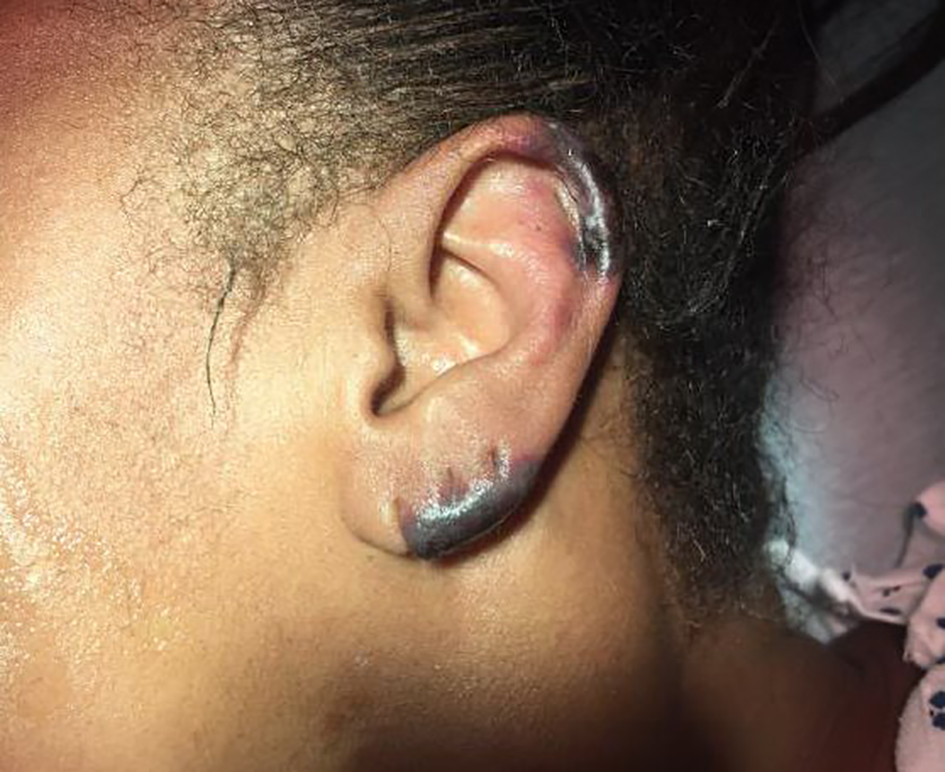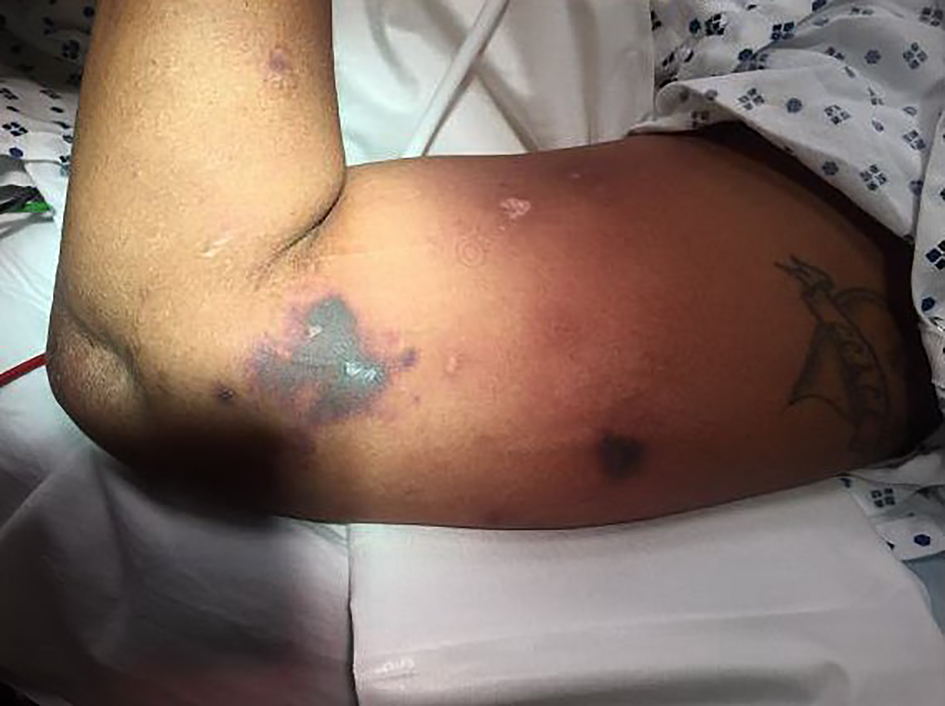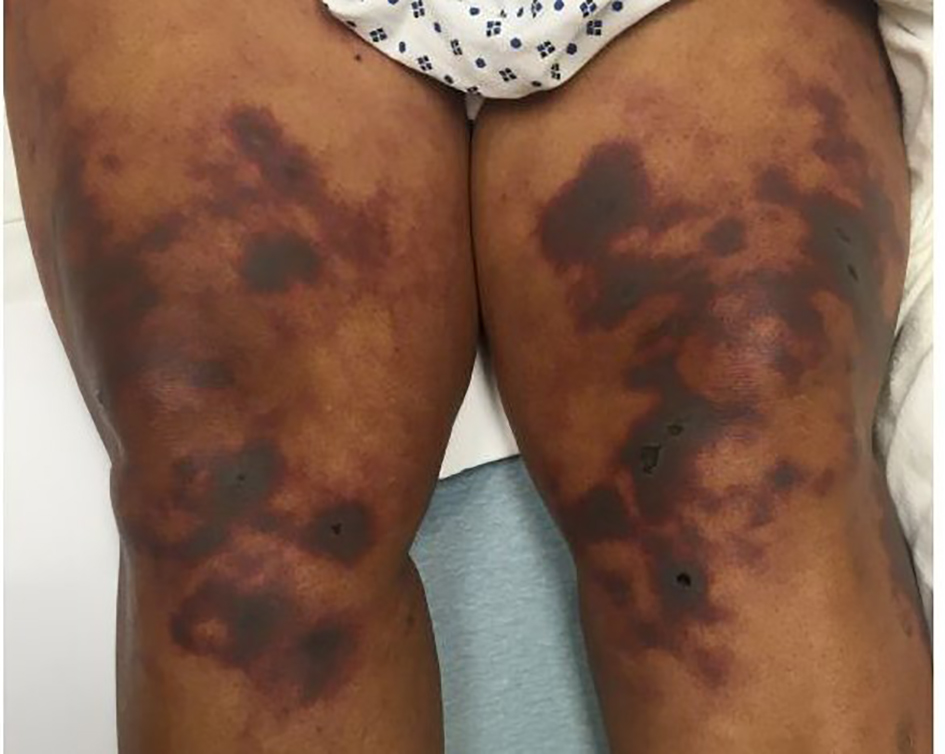| Journal of Medical Cases, ISSN 1923-4155 print, 1923-4163 online, Open Access |
| Article copyright, the authors; Journal compilation copyright, J Med Cases and Elmer Press Inc |
| Journal website http://www.journalmc.org |
Case Report
Volume 7, Number 7, July 2016, pages 270-273
Suspected Infective Endocarditis Finally Turned Out to Be Levamisole-Induced Vasculitis: A Case Report and Review of Literature
Krishna Prasad Joshia, b, Joseph Hunter Holthoffa, Robert W. Bradshera
aDepartment of Internal Medicine, University of Arkansas for Medical Sciences (UAMS), Little Rock, AR, USA
bCorresponding Author: Krishna Prasad Joshi, Department of Internal Medicine, University of Arkansas for Medical Sciences (UAMS), Little Rock, AR, USA
Manuscript accepted for publication May 18, 2016
Short title: Levamisole-Induced Vasculitis
doi: http://dx.doi.org/10.14740/jmc2538w
| Abstract | ▴Top |
Levamisole is an immune-modulating drug with serious side effects including neutropenia and necrotizing vasculitis. Cocaine is often adulterated with levamisole to potentiate its action. Levamisole-induced vasculitis seen in cocaine users presents diagnostic challenges since it is rare and mimics clinical features of other diseases. It typically presents with a purpuric rash that can involve the nose, ears, cheeks, and extremities. Laboratory findings include leukopenia, lymphocytosis and anti-neutrophil cytoplasmic antibodies (ANCA). No therapies other than supportive care have been found to be effective. Early recognition is critical for supportive therapy and avoidance of potentially harmful therapies like corticosteroids. We report a case of levamisole-induced vasculitis which was suspected to have infective endocarditis at admission.
Keywords: Levamisole; Vasculitis; Cocaine; Endocarditis
| Introduction | ▴Top |
Levamisole is an immunomodulating drug that was once approved for use in human for various cancers and rheumatoid arthritis by US Food and Drug Administration (FDA). But, because of its serious side effects like severe neutropenia and necrotizing vasculitis, it was withdrawn from the market [1]. Levamisole is postulated to potentiate the effect of cocaine by increasing the number of D1 dopamine receptors in the brain. According to the reports from CDC, levamisole adulteration is found in up to 70% of the cocaine seized at the borders of the United States [2]. Since more than 1.5 million people in the United States use cocaine and more than 70% of the cocaine in US is adulterated with levamisole, the incidence of levamisole-induced vasculitis will continue to rise [3]. As the history of drug use is not always provided by patient and the manifestation of levamisole toxicity overlaps with other medical conditions, strong clinical suspicion with appropriate test is needed for prompt diagnosis and appropriate management. We report a case of vasculitis rash in a female with intravenous (IV) drug abuse which was suspected as infective endocarditis at admission and finally turned out to be levamisole-induced vasculitis.
| Case Report | ▴Top |
A 53-year-old African American female with a past medical history of hypertension, chronic kidney disease, polysubstance abuse and hepatitis C presented to emergency department with the complaints of fever, chills, diaphoresis, and body ache for 1 week and rashes for 2 days. Five days after the onset of fever, she developed dark and painful skin lesions that appeared first on the ears followed by upper arms and both thighs over a period of 2 days (Figs. 1-4). She reported burning pain and itching without bleeding, oozing or blisters around the rashes. She denied any recent travel, tick bites, use of new medication or weight loss. Systemic review was negative for headache, cough, chest pain, shortness of breath, abdominal pain, hematuria or joint pain. She reported smoking cigarettes half pack a day for last 40 years. She also reported IV drug abuse including cocaine and the most recent cocaine use was 2 days prior to onset of rash. The history of drug use was inconsistent when asked by multiple providers. She would say she quit the drug many days ago at times and once said that she took cocaine few days ago. Physical examination in emergency department revealed elevated blood pressure 217/131 mm Hg, HR 115/min, temperature 99 °F, and RR 15/min. Skin examination revealed dusky deeply violaceous well-demarcated patches on the bilateral ear helices (Figs. 1, 2). Small dark violaceous to necrotic appearing purpuric patches on the bilateral upper arms were present (Fig. 3). Extensive involvement of the bilateral anterior thighs from the groin to the knees with dark retiform purpuric patches with erythematous borders and central erosive lesions was also noted (Fig. 4). No abnormalities were noted on CNS, cardiovascular, respiratory and GI systems. In the context of IV drug use and presence of fever with rashes, a diagnosis of infective endocarditis was suspected with the differential diagnosis of tick borne illness, vasculitis and autoimmune disorders. The hypertensive urgency was treated with hydralazine and nifedipine. Lab tests revealed leukopenia with WBC of 2,590/mm3 with 43% neutrophils and 50% lymphocytes. Hemoglobin was 12.8 g/dL with platelet count of 146,000/mm3. DIC panel showed normal fibrinogen, normal PT/INR and slightly increased APTT of 44. Antibiotics were started empirically for infective endocarditis but were discontinued after blood cultures were negative and echocardiogram did not show vegetation. Over next few days, the lesions started developing blisters with oozing and crusting. Dermatology, wound care and general surgery were consulted. Supportive care with pain management, wound care and nutrition management was started. Investigations for tick borne illnesses were negative for Rocky Mountain spotted fever IgM/IgG and Ehrlichia/anaplasma polymerase chain reaction. With the background of chronic hepatitis C infection, cryoglobulinemia was also suspected but serum cryoglobulin test was negative. Hepatitis C polymerase chain reaction showed 688,593 copies/mL but hepatitis B and HIV tests were negative. The skin lesions showed some improvement with wound care management, dressing changes and application of emollients. Vasculitis workup showed negative antinuclear antibody (ANA) with rheumatoid arthritis (RA) factor was mildly elevated to 26. Anti-neutrophil cytoplasmic antibody (ANCA) IgG antibody was markedly elevated to 1:10,240 and perinuclear-ANCA (p-ANCA) was normal with cytoplasmic ANCA (c-ANCA) markedly elevated to 208. Complement studies showed normal C3 and C4 levels. The admission urine drug screen was positive for cocaine and opiate. Biopsy of the skin lesions showed ischemic necrosis of epidermal, dermal and subcutaneous tissue. The dermis and subcutaneous tissue demonstrated numerous occlusive fibrin thrombi within small vessels with focal leukocytoclasis and vascular damage suggestive of levamisole-induced vasculitis. After 2 weeks of hospital stay, she was discharged with plan to follow-up in burn unit for the skin grafting. At the time of discharge, the WBC count had increased to 5,190/mm3 and platelet count of 41,000/mm3 with Hb 9.1 g/dL. Skin grafting was done at the burn unit and pain management was done with opioids. After skin grafting, the skin lesions healed well. Patient was on continuous follow-up for physiotherapy, pain management and wound care.
 Click for large image | Figure 1. Vasculitis rash on right ear. |
 Click for large image | Figure 2. Rash on left ear. |
 Click for large image | Figure 3. Rash on upper limb. |
 Click for large image | Figure 4. Rash on bilateral lower limbs. |
| Discussion | ▴Top |
Cocaine is a common problem in USA with more than 2 million people using it [2]. It has been a common practice to adulterate the cocaine with levamisole for potentiating the effects of cocaine. Since the first report of adulteration in 2002, the percentage of cocaine adulterated with levamisole is rising steadily to as high as 70-82% [2, 3]. This case describes a patient with neutropenia, skin rashes and vasculitis secondary to use of cocaine adulterated with levamisole. Levamisole was originally approved for use as an immunomodulatory drug in various diseases including nephrotic syndrome and other autoimmune diseases. There are case reports of vasculitis associated with levamisole when it was used for RA [1] and in children with nephrotic syndrome [4]. In all these cases, neutropenia and skin lesions resolved after the discontinuation of levamisole. The drug was finally withdrawn from the human market in 1999 because of serious side effects including leukopenia, agranulocytosis, and skin vasculitis [5]. In our patient, after the patient stopped taking cocaine, leucopenia and neutropenia improved with improvement in skin lesions.
Levamisole is believed to act by two mechanisms to increase the effect of cocaine. Firstly, it inhibits monoamine oxidase and catechol-O-methyltransferase activity resulting in prolonging the action of catecholamine in the neuronal synapse and increasing the reuptake-inhibition effect of cocaine. Levamisole also enhances euphoric and addictive properties of cocaine by increasing dopamine [6]. Levamisole-induced vasculitis syndrome presents with typical findings of vasculopathic purpuric rash involving mainly the ears but can involve nose, cheeks and extremities diffusely [5, 7]. In our patient, the rash appeared first on earlobes and finally involved the other parts of body. Histopathological examination of the levamisole-induced vasculitis may show a mixed pattern of leukocytoclastic vasculitis, thrombotic vasculitis or vascular occlusion. In our patient, the microscopic examination of the tissue revealed the features consistent with levamisole-induced vasculitis.
Levamisole-induced vasculitis has interesting laboratory findings. Leukopenia, lymphocytosis and presence of anti-neutrophil antibodies are seen because of immunomodulatory effects. Presence of ANCA is variable. p-ANCA is found in 86-100% of cases and c-ANCA is found in 50% of the cases [8]. In our patient, p-ANCA was negative but c-ANCA was found to be positive.
The skin lesions usually resolve spontaneously within a few weeks of the discontinuation of levamisole. No therapies other than discontinuation of levamisole have been found to be effective. The use of corticosteroid is controversial and its use has not been found to improve or accelerate healing and is not routinely recommended. Furthermore, since the most reported cases do not have internal organ involvement, the steroid is not needed and may in fact be harmful because of serious side effects [9]. There are reports of the use of plasmapheresis in case reports but we currently have no enough data to support or preclude its use [10]. In our patient, no corticosteroid or plasmapheresis was used and the skin lesions improved with the discontinuation of cocaine. Since the damage to skin was extensive with involvement of dermis and subcutaneous tissue, skin grafting was done. Patient has continued to improve on follow-up.
Conclusion
Levamisole-induced vasculitis is a cutaneous vasculitis syndrome associated with the use of cocaine adulterated with levamisole. With the increase in cocaine abuse and adulteration of cocaine with levamisole, the rate of levamisole-induced vasculitis seems to be increasing. When a patient presents with purpuric skin rashes including involvement of ear lobes, levamisole-induced vasculitis should be suspected. Appropriate investigations for vasculitis, drug screen test with skin biopsy should be done to diagnose it for timely and appropriate treatment. Although corticosteroids and plasmapheresis have been tried in case reports, no definitive benefit has been demonstrated. The therapy is mostly supportive with pain management, wound care and discontinuation of cocaine adulterated with levamisole.
| References | ▴Top |
- Macfarlane DG, Bacon PA. Levamisole-induced vasculitis due to circulating immune complexes. Br Med J. 1978;1(6110):407-408.
doi - Centers for Disease Control and Prevention (CDC). Agranulocytosis associated with cocaine use-four states, March 2008-November 2009. Morbidity and Mortality Weekly Report. 2009;58(49):1381-1385.
pubmed - http://www.drugabuse.gov/publications/drugfacts/nationwide-trends. Accessed on 14th April, 2016.
- Rongioletti F, Ghio L, Ginevri F, Bleidl D, Rinaldi S, Edefonti A, Gambini C, et al. Purpura of the ears: a distinctive vasculopathy with circulating autoantibodies complicating long-term treatment with levamisole in children. Br J Dermatol. 1999;140(5):948-951.
doi pubmed - Chang A, Osterloh J, Thomas J. Levamisole: a dangerous new cocaine adulterant. Clin Pharmacol Ther. 2010;88(3):408-411.
doi pubmed - Chung C, Tumeh PC, Birnbaum R, Tan BH, Sharp L, McCoy E, Mercurio MG, et al. Characteristic purpura of the ears, vasculitis, and neutropenia - a potential public health epidemic associated with levamisole-adulterated cocaine. J Am Acad Dermatol. 2011;65(4):722-725.
doi pubmed - Trimarchi M, Gregorini G, Facchetti F, Morassi ML, Manfredini C, Maroldi R, Nicolai P, et al. Cocaine-induced midline destructive lesions: clinical, radiographic, histopathologic, and serologic features and their differentiation from Wegener granulomatosis. Medicine (Baltimore). 2001;80(6):391-404.
doi - McGrath MM, Isakova T, Rennke HG, Mottola AM, Laliberte KA, Niles JL. Contaminated cocaine and antineutrophil cytoplasmic antibody-associated disease. Clin J Am Soc Nephrol. 2011;6(12):2799-2805.
doi pubmed - Gross RL, Brucker J, Bahce-Altuntas A, Abadi MA, Lipoff J, Kotlyar D, Barland P, et al. A novel cutaneous vasculitis syndrome induced by levamisole-contaminated cocaine. Clin Rheumatol. 2011;30(10):1385-1392.
doi pubmed - Pavenski K, Vandenberghe H, Jakubovic H, Adam DN, Garvey B, Streutker CJ. Plasmapheresis and steroid treatment of levamisole-induced vasculopathy and associated skin necrosis in crack/cocaine users. J Cutan Med Surg. 2013;17(2):123-128.
doi pubmed
This is an open-access article distributed under the terms of the Creative Commons Attribution-NonCommercial 4.0 International License, which permits unrestricted non-commercial use, distribution, and reproduction in any medium, provided the original work is properly cited.
Journal of Medical Cases is published by Elmer Press Inc.


